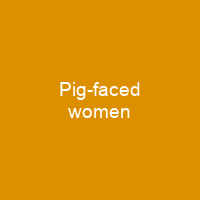Legends of the Pig-faced Lady: A Curious Tale
Have you ever heard of the mysterious and eerie legends surrounding pig-faced women? These tales have captivated imaginations for centuries, weaving through the fabric of history like a shadowy thread. In the late 1630s, these stories began to emerge in The Netherlands, England, and France, painting vivid pictures of wealthy women whose faces bore an uncanny resemblance to pigs.
The Origins
Imagine a wealthy woman with a body like any other but a face that would make you gasp. This was the essence of the earliest legends, where witchcraft played a central role in transforming these noble ladies into pig-faced beings. Over time, as magical elements were stripped away, the stories evolved, and the existence of such women became more widely believed.
Notable Tales
In Dublin, whispers circulated about a reclusive philanthropist named Griselda Steevens having a pig-like face. Meanwhile, in London, tales of a ‘pig-faced woman’ living in Marylebone spread like wildfire, with numerous alleged portraits published. These stories were not just whispered in the shadows; they became public spectacles, with showmen exhibiting living ‘pig-faced women’ at fairs.
These exhibits were likely shaven bears dressed as women, a clever trick to fool the audience into believing in the authenticity of these tales. The legend’s decline was marked by the publication of the last significant work treating pig-faced women as genuine in 1924. Today, the legend is almost forgotten.
The Legend of Tannakin Skinker
One of the earliest recorded references to this legend comes from The fable of Tannakin Skinker, a 17th-century variation on the traditional loathly lady story. Between 4 and 11 December 1639, five ballads about Skinker were published in London, all now lost. A Certaine Relation of the Hog-faced Gentlewoman called Mistris Tannakin Skinker claims that she was born to Joachim and Parnel Skinker in 1618 with a pig’s snout.
The midwife who delivered her was sworn to secrecy, but soon enough, locals came to hear her pig-like speech or watch her feed from a silver trough. At the age of 16-17, Tannakin’s father consulted Vandermast, ‘a famous Artist, who was both a Mathematician and an Astrologian […]’ as to how the curse might be undone.
Vandermast concluded that as long as Tannakin remained a virgin she would retain her pig’s face. However, if she were married to a gentleman of high rank, she could be cured. The Skinker family offered a dowry of £40,000 to any gentleman who would marry their daughter Tannakin. Despite numerous suitors, none were willing due to her unusual appearance.
On the wedding day, despite efforts to improve her appearance, she revealed her true face, which was that of a pig. In a dramatic turn of events, she presented her husband with a choice: she would be beautiful to him alone or hideous to all his friends. The husband chose the former, and in doing so gave her control over their marriage.
The Pig-faced Lady of Manchester Square
Another tale that gained widespread belief was the story of the ‘Pig-faced Lady’ of Manchester Square. This legend began circulating in 1815, claiming she was Irish, from a wealthy family, and ate from a silver trough. Thousands believed her existence, but eventually, newspapers started to debunk the story as a hoax.
The Times newspaper initially published an advertisement from a young woman offering herself as the Pig-faced Lady’s companion for a handsome income and living arrangements. Later, another advertisement from a man proposing marriage to the Pig-faced Lady was ridiculed by The Times, leading rival newspapers to defend her honour.
Artistic Depictions
The Pig-faced Lady of Manchester Square is a subject of art from the early 19th century. On March 21, 1815, a colored print by George Cruikshank was published titled ‘The Pig Faced Lady of Manchester Square and the Spanish Mule of Madrid’. The image shows the Pig-faced Lady, an 18-year-old woman with high rank and great fortune, wearing a transparent veil, playing the piano, and eating from a silver trough. Her face resembles that of a pig.
Facing her is Ferdinand VII of Spain, shown with a mule’s head, sitting on a throne, and engaging in violent activities. The Pig-faced Lady is described as rejecting suitors with grunts, and a drawing called Waltzing a Courtship shows her dancing with a man who bears a strong resemblance to Lord Kirkcudbright.
Exhibits at Fairs
Exhibits on pig-faced women became popular at fairs in the 19th century. Prints of The Wonderful Mrs Atkinson were displayed at early Irish fairs, while larger fairs included exhibits of pig-faced women moulded in papier-mâché or wax. A living pig-faced woman was allegedly exhibited at Bartholomew Fair in 1828.
These exhibits were not genuine. Showmen would drug a bear, shave it, and then dress it up as a woman using artificial breasts, shoes, gloves, and clothing. The audience was allowed into the tent once the bear was dressed, and it was securely tied to a chair for their entertainment.
The Pig-faced Lady Craze
The legend of the Pig-faced Lady gained popularity in the 19th century, with Charles Dickens commenting on its ubiquity at fairs. However, by the 1860s, the fad had begun to decline. The legend was revived in Sheridan Le Fanu’s novel Uncle Silas, which tells the story of a wealthy heiress who is targeted by scheming men. The novel includes a ‘Bretagne ballad’ about the Pig-faced Lady, sung to the protagonist by her governess.
Conclusion
The legend of the pig-faced woman has faded into obscurity, leaving behind only faint echoes in Dublin’s Dr Steevens’ Hospital. Yet, these tales continue to intrigue us, reminding us that sometimes, the most fascinating stories are those that blend fact and fiction, reality and myth.

You want to know more about Pig-faced women?
This page is based on the article Pig-faced women published in Wikipedia (retrieved on November 30, 2024) and was automatically summarized using artificial intelligence.







